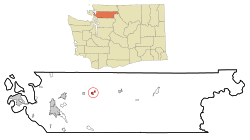2010 census
As of the 2010 census, [4] there were 301 people, 116 households, and 80 families living in the town. The population density was 266.4 inhabitants per square mile (102.9/km2). There were 141 housing units at an average density of 124.8 per square mile (48.2/km2). The racial makeup of the town was 90.4% White, 2.0% Native American, 3.7% from other races, and 4.0% from two or more races. Hispanic or Latino of any race were 4.3% of the population.
There were 116 households, of which 31.9% had children under the age of 18 living with them, 51.7% were married couples living together, 9.5% had a female householder with no husband present, 7.8% had a male householder with no wife present, and 31.0% were non-families. 19.0% of all households were made up of individuals, and 1.7% had someone living alone who was 65 years of age or older. The average household size was 2.59 and the average family size was 2.99.
The median age in the town was 40.5 years. 23.9% of residents were under the age of 18; 9.6% were between the ages of 18 and 24; 25.9% were from 25 to 44; 30.5% were from 45 to 64; and 10% were 65 years of age or older. The gender makeup of the town was 48.5% male and 51.5% female.
2000 census
As of the 2000 census, [5] there were 309 people, 117 households, and 80 families living in the town. The population density was 313.2 people per square mile (120.5/km2). There were 135 housing units at an average density of 136.8 per square mile (52.7/km2). The racial makeup of the town was 91.91% White, 3.56% Native American, 0.65% Asian, 1.62% from other races, and 2.27% from two or more races. Hispanic or Latino of any race were 2.91% of the population.
There were 117 households, out of which 35.0% had children under the age of 18 living with them, 47.0% were married couples living together, 11.1% had a female householder with no husband present, and 30.8% were non-families. 20.5% of all households were made up of individuals, and 2.6% had someone living alone who was 65 years of age or older. The average household size was 2.64 and the average family size was 2.91.
In the town, the age distribution of the population shows 27.8% under the age of 18, 6.1% from 18 to 24, 34.3% from 25 to 44, 23.6% from 45 to 64, and 8.1% who were 65 years of age or older. The median age was 36 years. For every 100 females, there were 127.2 males. For every 100 females age 18 and over, there were 123.0 males.
The median income for a household in the town was $31,500, and the median income for a family was $34,063. Males had a median income of $33,542 versus $22,969 for females. The per capita income for the town was $13,531. About 21.2% of families and 22.8% of the population were below the poverty line, including 28.0% of those under the age of eighteen and none of those 65 or over.


